
How to Use TFT 4.0 INCH: Examples, Pinouts, and Specs
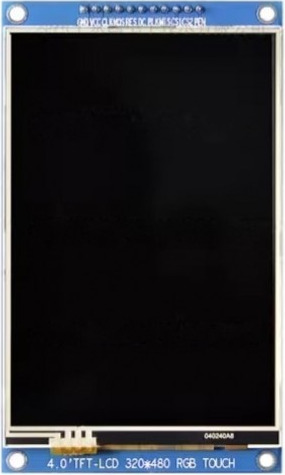
 Design with TFT 4.0 INCH in Cirkit Designer
Design with TFT 4.0 INCH in Cirkit DesignerIntroduction
The TFT 4.0 INCH display, powered by the SITRONIX ST7796S driver IC, is a high-resolution thin-film transistor (TFT) display designed for use in embedded systems and portable devices. This 4.0-inch display offers vibrant colors, excellent contrast, and a wide viewing angle, making it ideal for applications requiring graphical output, such as user interfaces, gaming devices, and industrial control panels.
Explore Projects Built with TFT 4.0 INCH
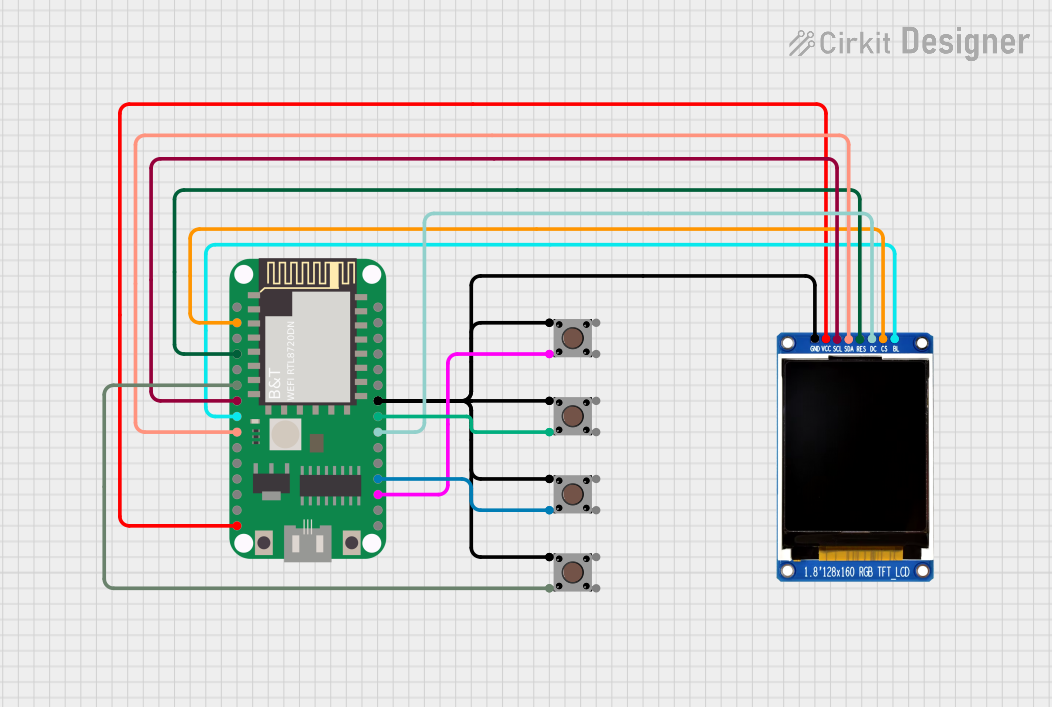
 Open Project in Cirkit Designer
Open Project in Cirkit Designer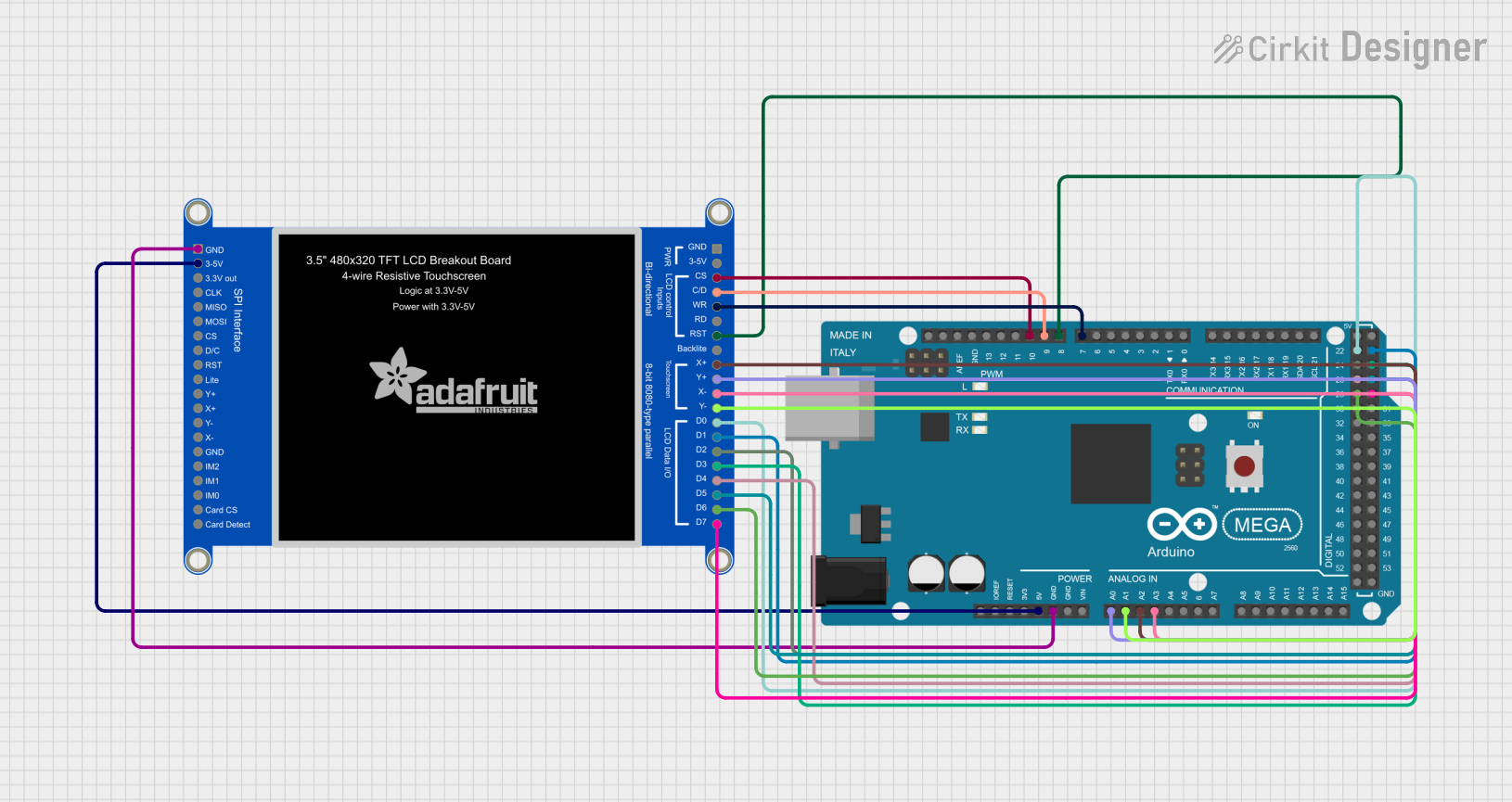
 Open Project in Cirkit Designer
Open Project in Cirkit Designer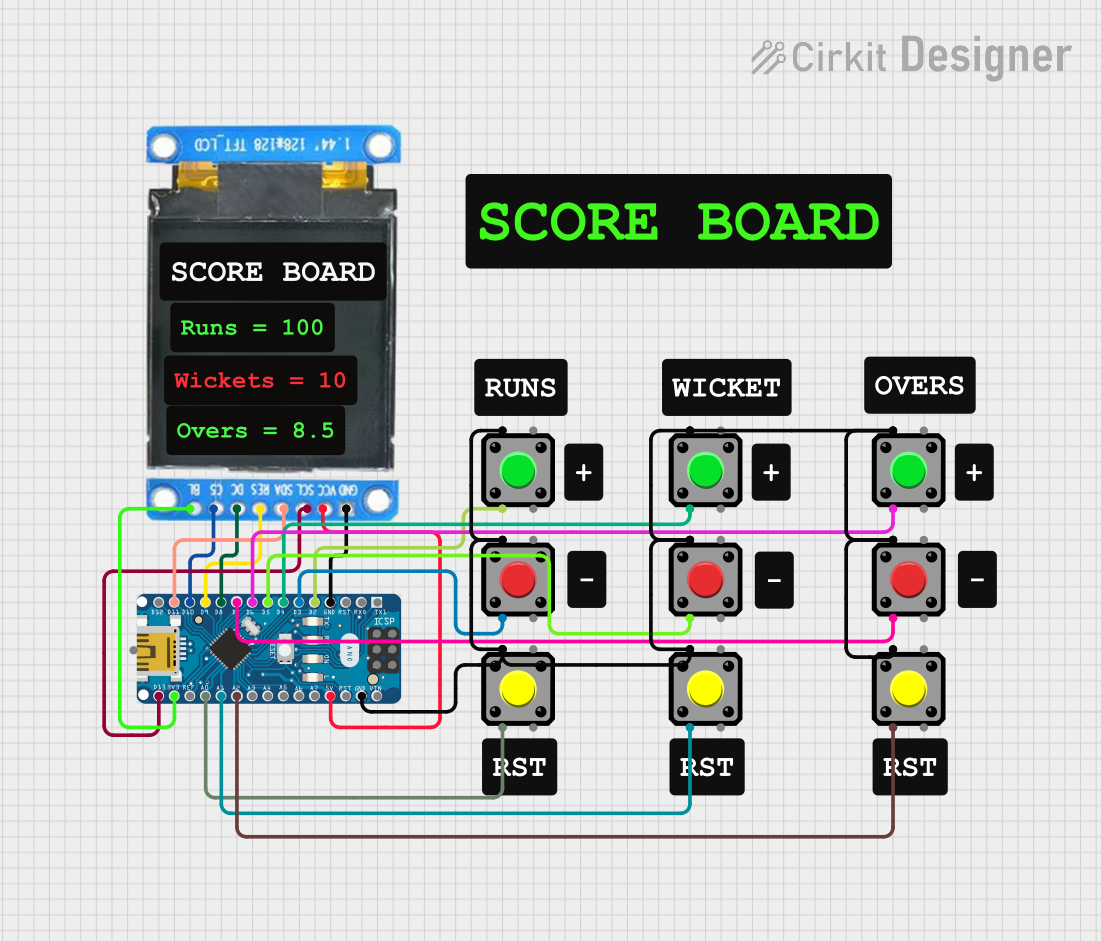
 Open Project in Cirkit Designer
Open Project in Cirkit Designer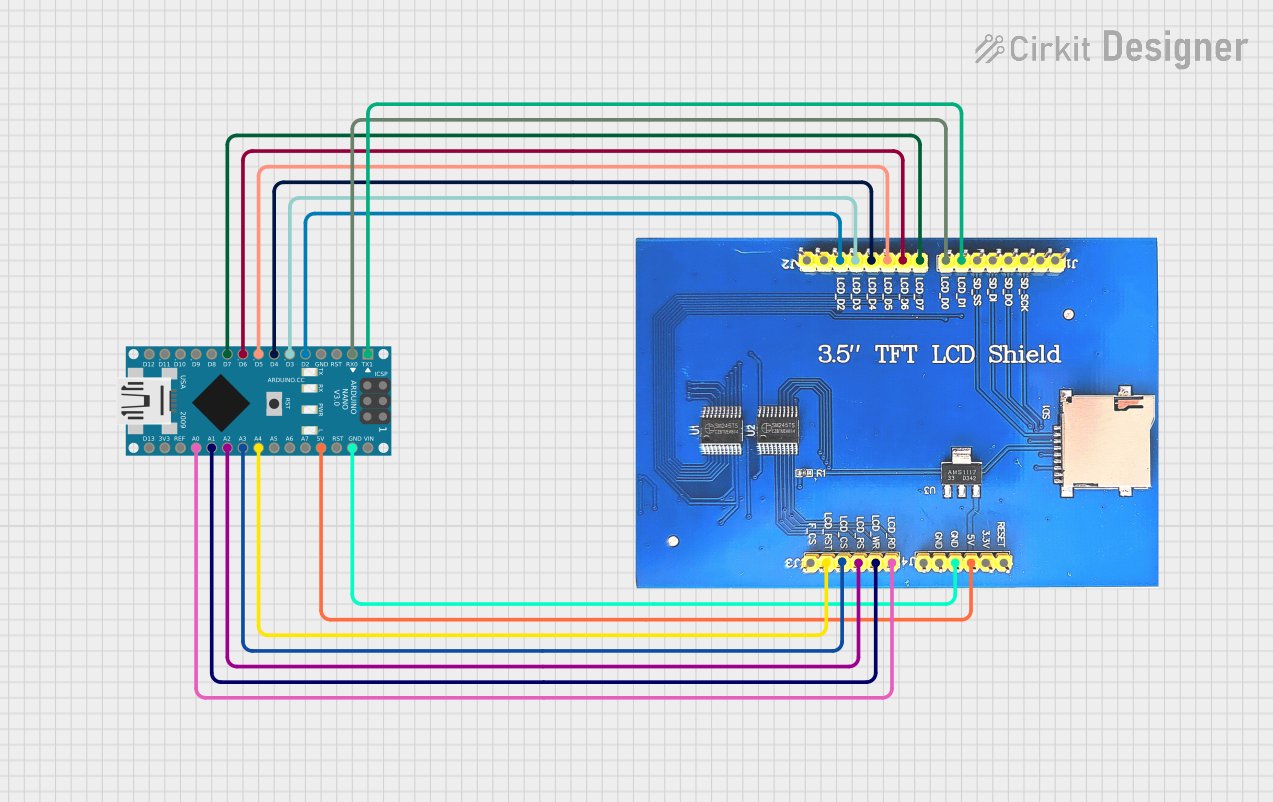
 Open Project in Cirkit Designer
Open Project in Cirkit DesignerExplore Projects Built with TFT 4.0 INCH

 Open Project in Cirkit Designer
Open Project in Cirkit Designer
 Open Project in Cirkit Designer
Open Project in Cirkit Designer
 Open Project in Cirkit Designer
Open Project in Cirkit Designer
 Open Project in Cirkit Designer
Open Project in Cirkit DesignerCommon Applications
- Embedded systems with graphical user interfaces
- Portable devices like handheld consoles and media players
- Industrial control systems and instrumentation
- Smart home devices and IoT displays
- Automotive dashboards and infotainment systems
Technical Specifications
The following table outlines the key technical specifications of the TFT 4.0 INCH display:
| Parameter | Specification |
|---|---|
| Display Size | 4.0 inches |
| Resolution | 480 x 320 pixels (RGB) |
| Driver IC | SITRONIX ST7796S |
| Interface | SPI / 8-bit / 16-bit parallel |
| Operating Voltage | 2.8V to 3.3V |
| Backlight Voltage | 3.0V to 3.6V |
| Backlight Current | 20mA to 40mA |
| Viewing Angle | Wide (up to 160°) |
| Operating Temperature | -20°C to 70°C |
| Storage Temperature | -30°C to 80°C |
Pin Configuration
The TFT 4.0 INCH display typically uses a 40-pin interface. Below is the pin configuration for the ST7796S-based display:
| Pin Number | Pin Name | Description |
|---|---|---|
| 1 | GND | Ground |
| 2 | VCC | Power supply (2.8V to 3.3V) |
| 3 | NC | Not connected |
| 4 | RESET | Reset signal (active low) |
| 5 | CS | Chip select (active low) |
| 6 | RS/DC | Register select / Data or Command control |
| 7 | WR | Write signal (active low) |
| 8 | RD | Read signal (active low) |
| 9-24 | DB0-DB15 | Data bus lines (used in parallel mode) |
| 25 | LED+ | Backlight anode |
| 26 | LED- | Backlight cathode |
| 27 | IM0 | Interface mode selection (SPI/parallel) |
| 28 | IM1 | Interface mode selection (SPI/parallel) |
| 29 | IM2 | Interface mode selection (SPI/parallel) |
| 30 | NC | Not connected |
| 31-40 | Reserved | Reserved for future use |
Usage Instructions
Connecting the TFT 4.0 INCH Display
- Power Supply: Connect the VCC pin to a 3.3V power source and the GND pin to ground.
- Backlight: Connect the LED+ and LED- pins to a suitable backlight driver circuit or directly to a 3.3V source with a current-limiting resistor.
- Interface Mode: Configure the IM0, IM1, and IM2 pins to select the desired interface mode (e.g., SPI or parallel).
- For SPI mode, set IM0 = 1, IM1 = 0, IM2 = 0.
- For 16-bit parallel mode, set IM0 = 0, IM1 = 1, IM2 = 1.
- Data and Control Pins: Connect the data bus (DB0-DB15) and control pins (CS, RS/DC, WR, RD) to the microcontroller or development board.
- Reset: Connect the RESET pin to a GPIO pin on the microcontroller for proper initialization.
Example: Using with Arduino UNO (SPI Mode)
Below is an example of how to connect and use the TFT 4.0 INCH display with an Arduino UNO in SPI mode:
Wiring
| TFT Pin | Arduino Pin |
|---|---|
| VCC | 3.3V |
| GND | GND |
| CS | D10 |
| RS/DC | D9 |
| RESET | D8 |
| SCK | D13 |
| MOSI | D11 |
| LED+ | 3.3V (via 100Ω resistor) |
| LED- | GND |
Code Example
#include <Adafruit_GFX.h> // Core graphics library
#include <Adafruit_ST7796S.h> // ST7796S driver library
#include <SPI.h>
// Define pins for the TFT display
#define TFT_CS 10 // Chip select
#define TFT_DC 9 // Data/command
#define TFT_RST 8 // Reset
// Create an instance of the display
Adafruit_ST7796S tft = Adafruit_ST7796S(TFT_CS, TFT_DC, TFT_RST);
void setup() {
// Initialize the display
tft.begin();
// Set rotation (0-3)
tft.setRotation(1);
// Fill the screen with a color
tft.fillScreen(ST77XX_BLUE);
// Draw a rectangle
tft.fillRect(50, 50, 100, 50, ST77XX_RED);
// Display text
tft.setTextColor(ST77XX_WHITE);
tft.setTextSize(2);
tft.setCursor(10, 10);
tft.print("Hello, TFT!");
}
void loop() {
// Nothing to do here
}
Best Practices
- Use a level shifter if your microcontroller operates at 5V logic levels, as the TFT operates at 3.3V.
- Add decoupling capacitors near the power pins to reduce noise.
- Avoid prolonged exposure to extreme temperatures to ensure display longevity.
Troubleshooting and FAQs
Common Issues
Display not turning on:
- Verify the power supply voltage (2.8V to 3.3V) and connections.
- Check the backlight connections (LED+ and LED-).
No image or incorrect display:
- Ensure the interface mode (SPI/parallel) is correctly configured using IM0, IM1, and IM2.
- Verify the wiring of data and control pins.
Flickering or unstable image:
- Check for loose connections or poor soldering.
- Add decoupling capacitors to stabilize the power supply.
Touchscreen not responding (if applicable):
- Ensure the touchscreen controller (if present) is properly connected and initialized.
FAQs
Q: Can I use the TFT 4.0 INCH display with a 5V microcontroller?
A: Yes, but you must use level shifters to convert 5V logic signals to 3.3V.
Q: What is the maximum refresh rate of the display?
A: The refresh rate depends on the interface mode and clock speed but typically ranges from 30Hz to 60Hz.
Q: Can I use this display outdoors?
A: The display is not sunlight-readable but can be used outdoors in shaded areas within the operating temperature range.
Q: Is the display compatible with Raspberry Pi?
A: Yes, the display can be used with Raspberry Pi via SPI or GPIO connections, but additional configuration may be required.